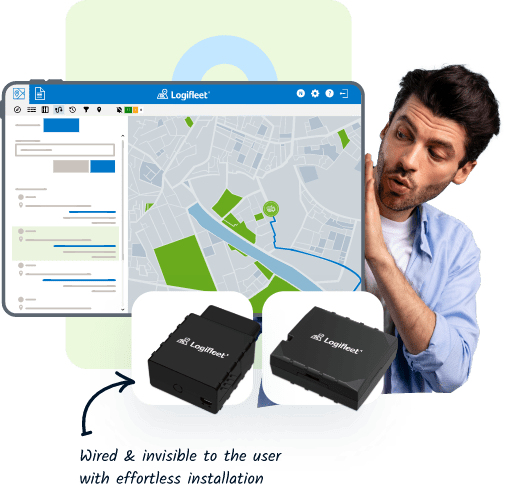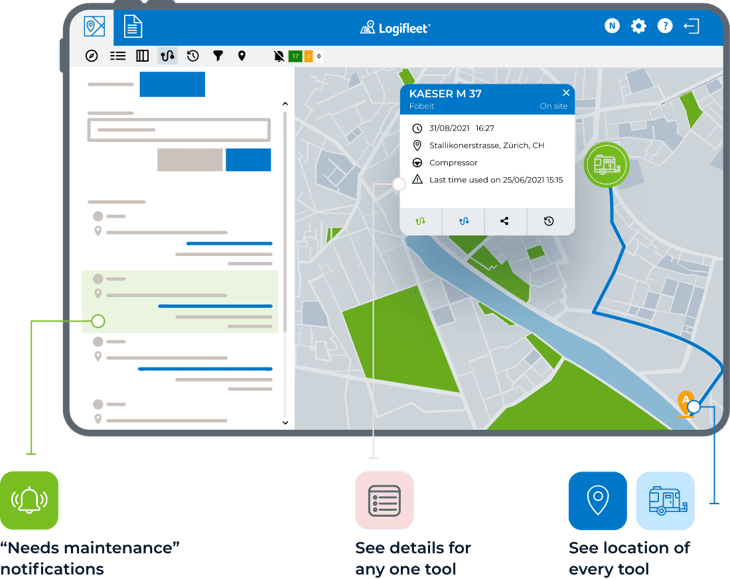The Ultimate Guide to Fleet Management Tracking
- 1 - What is “it”?
- 2 - What is fleet tracking?
- 3 - How does fleet tracking work?
- 4 - What are some common use cases for fleet tracking?
- 5 - Common Myths about Fleet Tracking
- 1 - Top 10 Benefits of Fleet Tracking
- 2 - Fleet Monitoring Software: Essential Features and Benefits
- 3 - Never Miss Another Fleet Tune-up with this Tool
- 4 - The Simple Way to Maximize Fleet Productivity
- 5 - The Fastest Way to Increase Fleet Profitability
- 6 - How to Improve Fleet Utilization
- 7 - Easy Sustainability Tips for a Greener Fleet in 2021
What is “it”?
Your competitors are probably using it. The whole industry is talking about it. Your employees are wondering if your company will start using it, too.
What is “it”? Fleet tracking.
Fleet tracking, a.k.a “telematics” was popularized in the 1990s. Over the past few decades, this technology has evolved and adapted into a robust powerhouse. But often it’s still met with understandable doubts and concerns. Myths and fears about fleet tracking may prevent fleet managers from trying out a software that could revolutionize the way they do business.
Did you know? 79% of fleets using GPS fleet management software consider it important to running efficient operations. (Driscoll, 2018)
This ultimate guide will dispel common objections and show you the powerful benefits of fleet tracking. It will explain the basics of how the technology works and why you need to include it in your fleet management strategy.
What is fleet tracking?
Put simply, fleet tracking uses software and hardware to monitor fleet assets’ location, activity and productivity.
How does fleet tracking work?
Businesses of all sizes across dozens of industries benefit from fleet tracking. It’s easy to set up the one-time, plug-and-play hardware on each vehicle. This hardware can be battery-operated or hooked up to the vehicle’s electrical system.

Once installed, the hardware automatically tracks and sends data to a cloud-based software. Managers can access real-time and historic data anywhere, at any time. The information is backed up, secured and never shared with third parties.
Learn more about getting started with fleet tracking and the installation process.
What are some common use cases for fleet tracking?
Many business owners wonder, “Will it work for my business?”. The answer is a resounding yes! Fleet tracking benefits fleets of all shapes and sizes.
Many industries already rely on fleet tracking for their daily operations. These include:
Public Works
Construction
Utilities
Food Delivery
Tool Rental
Painting
Cleaning & Sanitation
IT
Manufacturing
Retail & Wholesale
Here are three typical use cases for fleet tracking.
Damien owns a small construction company. He notices some tools and cargo have gone missing over the past few months. However, he has no way of knowing when or how this inventory was lost.
Fleet tracking reduces theft and inventory loss. It monitors all your tools, equipment and vehicles on one platform, 24/7, 365 days a year.
Florence suspects some of her drivers might be using company vehicles after-hours for personal trips and deliveries. However, it’s impossible for her to keep track of which vehicles are entering or leaving the warehouse and where they are going.
Fleet tracking automatically logs vehicle activities and keeps staff accountable around the clock.
Edward notices his fuel costs are skyrocketing, but he doesn’t know why. He has no way of tracking their driving behavior or the routes they take. This lack of visibility makes it hard for him to maintain a healthy profit margin.
Fleet tracking monitors fuel efficiency and reduces fuel costs by alerting managers about factors that reduce mileage (i.e. aggressive driving behavior, poor route management).
These three examples are just some of the common scenarios fleet managers face in their daily work. A comprehensive fleet management software can solve all of these problems...and more!
Common Myths about Fleet Tracking
If you’ve never used fleet tracking before, it can seem unnecessary or overly complicated. Fear not, it’s very easy to set up and use! The benefits far outweigh the initial set-up time and gentle learning curve. Here are some common questions and answers about fleet tracking.
-
Will I lose workers’ trust?
No! Fleet tracking benefits both the company and the employees! (See below)
-
Is it legal?
Yes! In fact, fleet tracking improves compliance with vehicular, traffic safety and environmental laws and regulations.
-
Is it micro-management?
No! Fleet tracking reduces micro-management by improving communications and setting clear standards for work quality and accountability.
-
Will it affect my warranty?
No. Reputable telematics companies produce high-quality hardware that will not affect your vehicle’s performance or void its warranty.
-
Will it waste drivers’ time?
No. Once installed, data is collected automatically. With Logifleet, drivers no longer need to fill out paper logs, log into a device or scan any codes.
-
Can I justify the expense?
Yes! You will see immediate ROI. With Logifleet, you can sign up for customized plans that fit your fleet size and budget.
Do you have more questions about fleet tracking? Contact us today and we’ll be happy to answer them.

The Impact of Fleet Tracking
Top 10 Benefits of Fleet Tracking
Believe it or not, fleet tracking has dozens of benefits for your business. Here are the top ten benefits that may contribute to immediate ROI for your company.
-
Faster, Better Decision-Making
Equipped with better data (both real-time and historic), fleet managers can make critical decisions faster. Decisions that not only impact the company’s bottom line, but ones that improve staff satisfaction and productivity, too.
-
Increased Team Productivity and Communication
With fleet tracking, cross-functional teams no longer work in silos. Data that was previously scattered and disorganized across multiple locations is now centralized on one accessible platform. This means less back-and-forth and miscommunication. Work also gets done faster, with less errors!
-
Better Route management and Optimization
Fleet management software like Logifleet also comes with route optimization tools to make sure each vehicle is always taking the most optimal route on a daily basis. This tool factors in driver schedules, service windows, traffic congestion and other time constraints, which is something other free tools (like Google Maps) cannot do.
-
Staying on Top of Maintenance
Fleet tracking software keeps track of when each vehicle was serviced. Managers can set up custom alerts to remind them about upcoming or overdue maintenance.
-
Staying Legally Compliant
Fleet tracking ensures drivers aren’t speeding or idling too much, as both of these can result in fines, liability and legal issues.
-
Monitor and Manage Fuel Costs
Fuel costs make up about 20% of a vehicle’s total cost of ownership (TCO) (Source: Deloitte). Good fleet managers understand that a company’s bottom line heavily depends on managing fuel costs. Fleet tracking closely monitors fuel usage and keeps detailed activity logs for each vehicle and driver. This helps companies actively manage behaviors that could result in unnecessary fuel wastage.
-
Keep Drivers Safer, More Accountable and Better Trained
Without enough visibility, it’s very difficult for managers to ensure drivers are safe on the road. Fleet tracking ensures drivers are following speed limits and other safety protocols. The hardware can notify managers about excessive idling time, aggressive driving or speeding. This way, managers can train their workers as needed and also have data to back up performance reviews.
-
Save Money while Improving Sustainability
Fleet tracking helps companies stay eco-friendly. Sustainability is important, especially in the fleet industry. Environmental stewardship not only improves brand image, it also saves money, too.
-
Lower Risk, Theft, Accidents and Liabilities
Fleet tracking mitigates many business risks such as cargo, equipment or vehicle theft. It reduces the likelihood of accidents too, which could cost companies a significant sum in legal and insurance fees.
-
Easier scheduling
By keeping tabs on all your vehicles in one place, it’s easy to spot under or over-used assets. Vehicle and driver scheduling is a breeze with fleet tracking. Never wonder if a vehicle is available - find out at a glance! All the information is in real-time, so managers won’t accidentally rent unnecessary equipment or make assignment errors.
Fleet Monitoring Software: Essential Features and Benefits
It might sound and look overwhelming at first, but don’t be intimidated! Modern fleet tracking software is very user-friendly. Here is a quick rundown on some common features.
-
GPS tracking & Geofencing (vehicles, equipment/tools, heavy machinery)
A professional telematics solution can pinpoint any vehicle’s real-time location and activity. GPS telematics, with the help of geofencing, can monitor and record every vehicle’s journey. Managers can also establish geo-zones for frequently-visited locations.
-
Fuel management logs
Monitor fuel consumption 24/7 and identify usage patterns. Set up alerts and get notified about unusual activity so you can warn drivers.
-
Driver behavior and vehicle activity and analytics
Zero in on underperforming drivers or risky behaviors. Fleet tracking software remotely monitors drivers to ensure they are upholding company policy and being responsible on the road.
-
Asset management and maintenance logs
Keep track of your entire fleet and all asset activity in one place. Automatic real-time updates means you’ll always be aware of which assets are entering or leaving, as well as where they are going. Maintenance notifications ensure all your vehicles are properly serviced on-time, every time.
-
Route optimization tool
No more wasted time and dissatisfied customers! Route optimization improves productivity and customer service. It also reduces fuel costs, which can save you thousands of Swiss francs a year.
Overview of Logifleet Products
Interested in trying out these features for yourself? Book a demo with Logifleet today to discover all the benefits of our comprehensive fleet management system.
Never Miss Another Fleet Tune-up with this Tool
It’s easy to miss a tune-up, even if you only have one or two vehicles. Imagine keeping track of maintenance schedules for dozens or hundreds of vehicles. That could be a job in and of itself! Luckily, with fleet tracking, managers don’t need to waste hours each week on administrative tasks.
Fleet management software automatically keeps track of when each vehicle was last serviced, and notifies managers when it’s due for another one. It will send out notifications for all upcoming or overdue maintenance. (Explore how maintenance reminders work here.)
Poorly-Maintained Vehicles:
- More prone to accidents
- Accidents = higher legal and insurance fees
- Frequent road-side breakdowns (that may require emergency towing or repairs)
- Could cause fines and collateral damage
- Reduced productivity and increased delays, which impact customer service
- May not be legally compliant
- Use more fuel
- Higher total cost of ownership
Properly-Maintained Vehicles:
- Less prone to accidents
- Less roadside breakdowns that require emergency repairs
- Safer for drivers and cargo
- Increased productivity and faster deliveries
- Better fuel efficiency (lower fuel costs)
- Lower total cost of ownership
- Higher resale price
- Longer vehicle lifespan
The Simple Way to Maximize Fleet Productivity
How often have you bought or rented a piece of equipment only to later realize you already had one lying around? How often do you waste time tracking down misplaced machines due to lack of organization and visibility?
It’s difficult to run a productive team when information exists in silos. It’s even more difficult if some or all of that information isn’t digitalized or shared on time.
One of the biggest benefits of fleet tracking is improved fleet productivity. Not only will you reduce equipment downtime, you’ll also become more organized, too. Communication becomes a breeze when data is easily tracked and shared.
Fleet tracking lets you know exactly where a vehicle or asset is, when you need it most. Everything is catalogued and updated in real-time. It saves time and money, without any extra effort on your part! (Learn more about maximizing fleet productivity here.)
Imagine the convenience that comes with this level of visibility. Fleet tracking software is the gamechanger you need to maximize fleet productivity.

The Fastest Way to Increase Fleet Profitability
Without fleet tracking, you could be scratching your head for days and not know how to eke out a single swiss franc from your already overstretched budget. In this increasingly competitive landscape, it’s getting harder to keep margins up and stay profitable.
Fleet tracking is the competitive edge you need right now to stay competitive. Once installed, many companies see an immediate ROI.
Here are just some of the ways you can instantly improve fleet profitability with fleet tracking:
- Pay less overtime (especially for administrative tasks)
- Pay less for fuel
- Pay less on insurance and legal fees
- Pay less for maintenance/repairs
- No more renting or buying unnecessary assets
Curious to see how you can save and make more money with fleet tracking? Learn more.
In addition to saving money, there are many broader benefits that help you make more money. Fleet tracking can improve overall customer satisfaction and brand reputation. Improved employee satisfaction could lead to lower recruitment fees. A productive company is one headed for growth, not struggling to keep up with the status quo.
Want to see a revenue lift without expending extra time or effort? Contact us today and we’ll show you how.
How to Improve Fleet Utilization
Whether your goal is to cut maintenance expenses or reduce fuel costs, establishing specific KPIs can help you. No matter which metrics you decide to track, fleet management software can help you gather and analyze the data you need to evaluate performance.
When it comes to fleet utilization metrics, here are the ones you need to track:
-
Mileage and Fuel Economy
Prevent redundant trips, unnecessary wastage, errors, delays and fraud by tracking trip data. Get automatic alerts when operators exceed their mileage limits (or don’t reach them).
You can track cost vs. revenue per vehicle or cost vs. revenue per kilometer.
When you compare the expenses vs. revenue generated for every vehicle and distance traveled, you will have a better picture of your fleet efficiency.
With fleet tracking, it’s easier to find out which vehicles are underperforming. This can help you make decisions about maintenance, selling or replacing the vehicle. You can also determine if drivers need better training to avoid bad habits that reduce fuel economy.
-
Vehicle Utilization Rate
Calculate your vehicle utilization rate by looking at the difference between fleet mileage capacity and actual mileage during a specific time period. This will show you whether or not your fleet’s capacity matches, exceeds or is insufficient for your business needs.
You can determine your fleet utilization rate with the help of fleet management software. Fleet tracking software gives you asset utilization logs to review performance. All the data is stored on one convenient platform and accessible from anywhere. This makes it much easier to make important decisions about your fleet size, budget and assignments.
You can reallocate resources to better meet demand, or sell unnecessary or underused vehicles. Not only will this improve productivity, it will reduce operational expenses, too.
-
Maintenance and Repair Costs
Are you wasting too much money constantly repairing older vehicles? Is your fleet experiencing undue wear and tear in its prime? Many of these warning signs could indicate dropping fleet performance. But what’s causing these issues?
Fleet tracking software can analyze driver behavior and asset utilization to help you determine the cause of your problems. It also actively reminds you about upcoming or overdue maintenance.
Learn how to hit all your fleet utilization KPIs (and more) here.
Easy Sustainability Tips for a Greener Fleet in 2021
Running a green fleet makes you look and feel good. Sustainable fleet practices make your brand appear more responsible. It could even help you win more business. But more importantly, an eco-friendly fleet saves more money, too, while remaining legally compliant.
The EU aims to reduce CO2 emissions by 80% up to 2050. This means newer vehicles must meet lower CO2 emissions, or face driving bans and higher taxes. Deloitte anticipates more fleets will start adopting low-emission vehicles within the next few years. (Source: Deloitte)
What will you do to keep your fleet sustainable? It should come as no surprise that reducing emissions means reducing fuel wastage. Reducing fuel costs will greatly improve your bottom line! By using fleet tracking software to monitor fuel consumption and fuel costs, you’re doing the environment and your wallet a huge favor!
Fleet tracking also tracks driver behaviors that often lead to fuel wastage. Harsh braking, excessive idling, speeding and more not only damages vehicles, but leads to more air pollution, too. Luckily, with fleet tracking, managers gain more insight into what’s happening on the road. This information can help them understand what changes to make in order to improve fleet sustainability.
A green fleet is a socially responsible fleet. As a member of the fleet industry, it’s up to each of us to ensure we are not causing undue environmental damage with our business practices.

In Conclusion
As the popularity of fleet tracking continues to rise, adopting this technology is essential if you want to stay competitive. From reducing fuel costs to extending vehicle lifespans, fleet tracking software will revolutionize your business processes from day one.
When is the “right” time to get started with fleet tracking? Now, of course! The sooner you switch over to telematics software, the sooner you can reap all the rewards.
This guide has only touched the tip of the iceberg when it comes to understanding telematics and its benefits for your business. Interested in learning more? Contact our team today to see Logifleet in action!